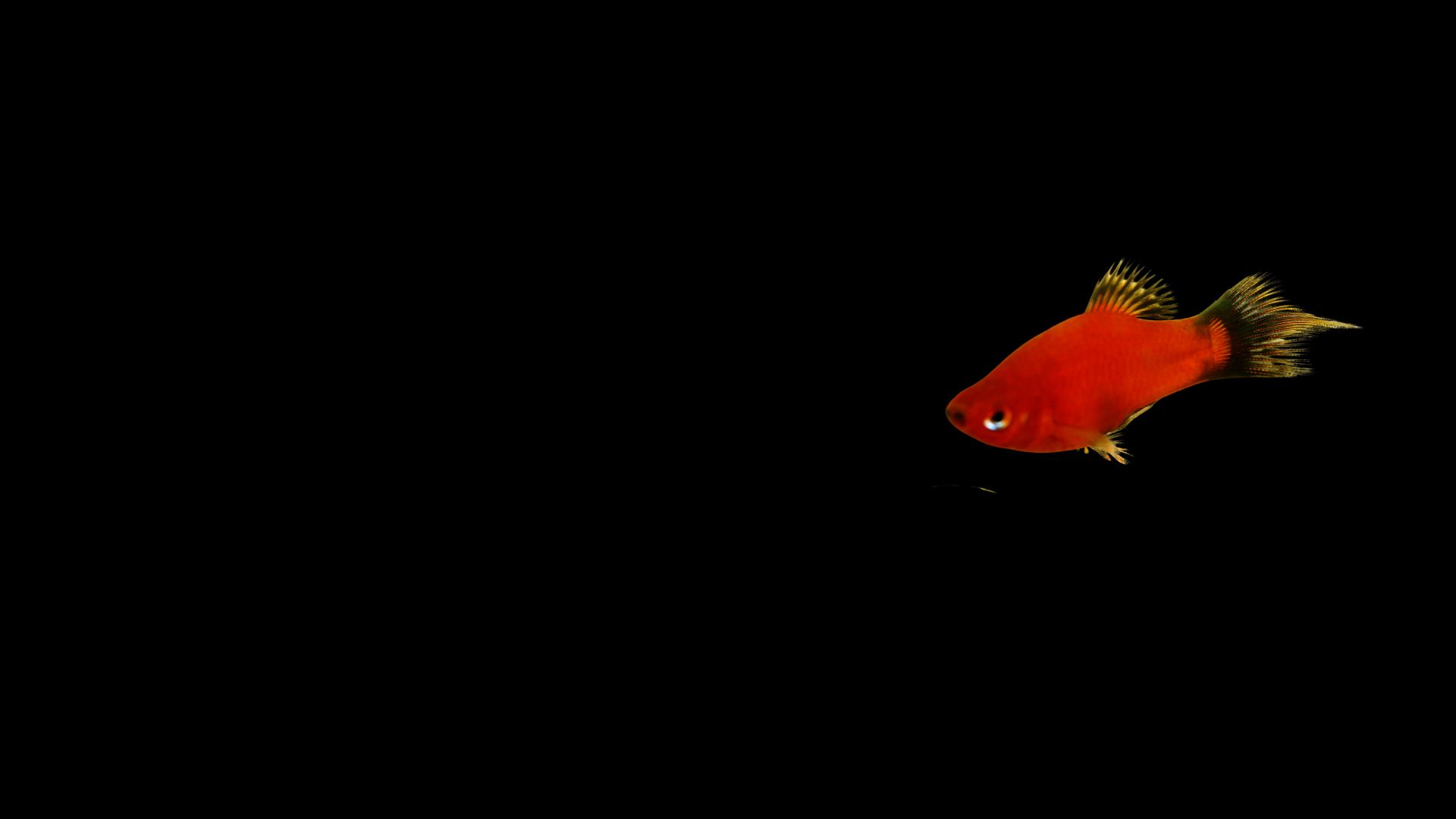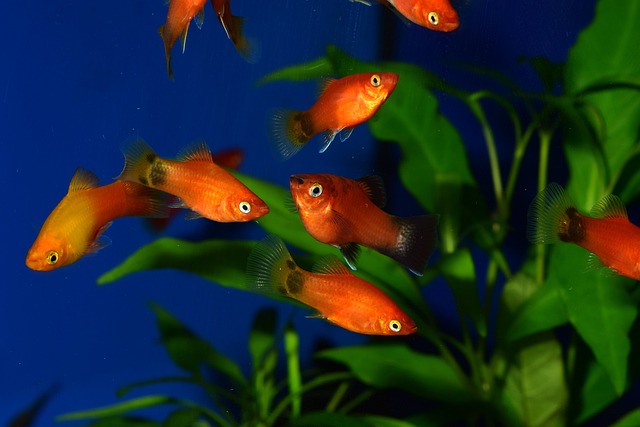
Platy
Scientific name: Xiphophorus maculatus
The Platy is a hardy, vibrant freshwater fish native to the rivers and canals of Central America, particularly in Mexico, Guatemala, and Honduras. Celebrated for its wide array of colors and patterns, the Platy adds a splash of brightness to any aquarium. These peaceful, active swimmers are excellent for community tanks, coexisting harmoniously with other non-aggressive species.
Their livebearing nature and ease of breeding make them a captivating choice for aquarists interested in observing fish reproduction firsthand. Platys are known for their adaptability to various water conditions, making them suitable for both novice and experienced fish keepers.
IUCN Red List of Threatened Species : Least Concern
Platys thrive when kept in groups of three or more. They are active throughout the aquarium, providing constant movement and interest. A well-planted tank with open swimming spaces enhances their environment and promotes natural behaviors.
As omnivores, they enjoy a varied diet that includes high-quality flake food, algae-based foods, and live or frozen foods like brine shrimp or daphnia. Their easygoing nature makes them compatible with a wide range of tank mates, including other livebearers and peaceful community fish.

Navite Location
Central America (Mexico, Guatemala, Honduras)
Varieties
Sunset / Mickey Mouse / Red Wagtail / Blue / Gold / Variatus
Suggested Tank Mates
Mollies / Swordtails / Guppies / Corydoras Catfish / Tetras (non-fin nippers) / Danios / Other peaceful community fish
Tank Mates to Avoid
Aggressive or fin-nipping fish / Large Cichlids / Tiger Barbs / Bettas (may be aggressive)
Diet
High-quality flake food / Algae-based foods / Live or frozen foods (brine shrimp, daphnia) / Vegetables (blanched spinach, peas)
Breeding
Platys are prolific livebearers, giving birth to live, free-swimming young. Females can produce 20 to 80 fry every 4 to 6 weeks under optimal conditions.
Lifespan
2 to 3 years with proper care
Size
Up to 6 cm (2.5 inches)
Minimum Tank Size
10 gallons (38 liters) for a small group; larger tanks are recommended for more individuals
Optimum Tank Temperature
22°C to 26°C (72°F to 79°F)
Ideal pH Level
7.0 to 8.2 (prefer slightly alkaline water)
Water Hardness
10 – 25 dGH (prefer moderately hard water)
Common Health Issues
Ich (White Spot Disease) / Fin Rot / Fungal Infections / Internal Parasites / Columnaris
Interesting facts
Color Variations Through Selective Breeding
Platys come in a multitude of colors and patterns due to extensive selective breeding, including unique varieties like the Mickey Mouse Platy, which has a pattern resembling Mickey Mouse’s head near the tail.
Easy to Breed
Their ease of breeding and high reproductive rate make Platys a popular choice for aquarists interested in breeding fish. They can store sperm and give birth multiple times from a single mating.
Hybridization with Swordtails
Platys can interbreed with Swordtails (Xiphophorus hellerii), producing viable hybrid offspring. This ability has led to many new color and fin variations in the aquarium trade.
Sexual Dimorphism
Males are generally smaller with a modified anal fin called a gonopodium used for reproduction. Females are larger with a rounder abdomen, especially when pregnant.
Hardy and Adaptable
Platys are tolerant of a range of water conditions, making them suitable for beginners. However, they still require clean, well-maintained water to thrive.
Platy FAQ’s
Do Platys Eat Their Fry?
Yes, adult Platys may eat their own fry if given the chance. Providing plenty of hiding places with plants or breeding grass can help increase the survival rate of the fry.
Can Platys Live with Betta Fish?
While Platys are generally peaceful, Betta fish may display aggression towards them due to their bright colors and active nature. Caution is advised when housing them together.
Do Platys Need a Heater?
Platys prefer warmer water temperatures between 22°C to 26°C (72°F to 79°F). In cooler climates or rooms with fluctuating temperatures, a heater is recommended to maintain a stable environment.
Do Platys Need Live Plants?
While not strictly necessary, live plants provide hiding spots, improve water quality, and create a more natural environment, which benefits Platys’ well-being.
Do Platy Fish Poop a Lot?
Platy fish, like all aquarium fish, produce waste as a natural part of their metabolism. However, they are not known to produce excessive waste compared to other fish of similar size, such as guppies or tetras. The amount of waste a platy produces largely depends on factors like diet, feeding frequency, and tank conditions.
Do Platy Fish Eat Snails?
Platy fish do not typically eat snails and should not be relied upon for snail control in your aquarium. They are more likely to live harmoniously with snails rather than view them as a food source. For effective snail management, consider alternative methods or introducing species known for consuming snails.
Can Platy Fish Store Sperm?
Yes, female Platy fish have the remarkable ability to store sperm from males for extended periods. This biological adaptation allows them to fertilize multiple batches of eggs over time without needing to mate again after the initial breeding.
As a result, a single mating event can lead to several successive broods of fry (baby fish) over the course of weeks or even months.
Do Platy Fish Die After Giving Birth?
No, platy fish do not typically die after giving birth. Under normal, healthy conditions, female platies can give birth multiple times throughout their lifespan without adverse effects on their health.
They are prolific livebearers, meaning they give birth to live, free-swimming fry rather than laying eggs, and this reproductive process is a natural and regular part of their life cycle.
Can Platy Fish Live in a Bowl?
While it is physically possible to place a platy fish in a bowl, doing so is not recommended and is detrimental to the fish’s health and well-being.
Platies are active, hardy fish that require adequate space, stable water conditions, and proper filtration to thrive. A bowl environment falls short in meeting these essential needs.
How Many Platies Can Safely Live in a 25-Litre Tank?
None! A 25-litre tank (approximately 6.6 gallons) is generally considered too small for keeping platy fish.
Platies are active, social creatures that thrive in groups and require ample space to swim and interact. For their well-being and to maintain a healthy aquarium environment, it’s important to consider several factors before deciding on the number of platies for your tank.
